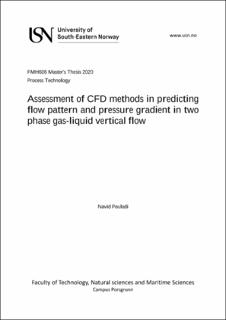| dc.description.abstract | Available tools for dealing with multi-phase flows are not effective with complex
geometries such as process piping with combination of horizontal and vertical pipes,
bends and valves. However, rapid development of computation power has made CFD a
more applicable tool in this field. This study aims to suggest and assess a CFD method to
deal with all flow patterns existing in a vertical two-phase gas-liquid upward flow.
A multi-fluid approach has been suggested where the Multifluid Eulerian and Volume of
Fluid (VOF) methods are used together, in combination with the interfacial area
concentration (IAC) equation.
The CFD results regarding flow pattern, void fraction and pressure gradient have been
compared to experimental results and a relatively good agreement has been observed. The
study found that the IAC equation plays an important role in predicting flow patterns.
However, a more sophisticated IAC equation and better models for bubble coalescence
and break-up could lead to a better performance of the multifluid model suggested.
The study concludes that the CFD method suggested is a reliable and applicable tool for
more complex geometries. However, further work is required to ensure this. | en_US |
